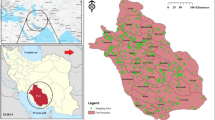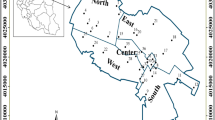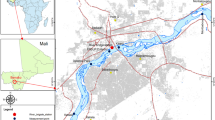Abstract
This study assessed non-cancerous health risk from exposure to mercury, arsenic and cadmium via oral ingestion of contaminated water bodies by resident children and adults in Nangodi, Upper East region, Ghana in accordance with US Environmental Protection Agency (USEPA). The mean concentration of arsenic, mercury and cadmium in water bodies in the study area for arsenic ranges from 0.0120 to 0.0653 mg/L; 0.0048 to 0.202 mg/L for mercury and 0.2665 to 1.090 mg/L for cadmium. These mean levels of arsenic, mercury and cadmium in water bodies from the study area were used as input parameters in calculating the non-cancerous health risk. The results of the non-cancerous health risk faced by resident children in the study area from exposure to mercury in a dug-well at Nakpadana is 6.7 via central tendency exposure parameter (CTE) and 13.0 via high end exposure parameter (HEE); in the case of arsenic we have 1.9 by CTE parameters and 3.7 by HEE parameters respectively, whilst for cadmium we had 29.0 and 58.0 by CTE and HEE parameters respectively. The non-cancerous health risk results expressed in terms of hazard quotient obtained in this study for both resident children and adults in most cases exceeded the acceptable USEPA hazard quotient value of 1.0, which suggests that resident adults and children are at high risk of showing symptoms associated with non-cancerous effects of exposure to arsenic, mercury and cadmium such as low IQ, tremor, renal failure, etc.
Similar content being viewed by others
References
Adadey E (1997) The role of the mining industry in the economy of Ghana. In: Proceedings of the national symposium on the mining industry and the environment. University of Science and Technology/International Development Research Centre Environmental Research Group, Accra, pp 10–17
Agyemang I (2010) Population dynamics and health hazards of small-scale mining activity in the Bolgatanga and Talensi-Nabdam districts of the upper east region of Ghana. Indian J Sci Technol 3(10):1113–1120
Amankwah RK, Anim-Sackey C (2003) Strategies for sustainable development of the small-scale gold and diamond mining industry of Ghana. Resour Policy 29:131–138
American Public Health Association (1998) Standard methods for the examination of water and wastewater, 20th edn. Washington
Amonoo-Neizer EH, Amekor EMK (1994) Determination of total arsenic in environmental samples from Kumasi and Obuasi, Ghana. Environ Health Perspect 101:46–49
Appiah H (1998) Organization of small-scale mining activities in Ghana. J S Afr Inst Min Metall 98(7):307–310
Aryee BNA (2001) Ghana’s mining sector: its contribution to the national economy. Resour Policy 27:61–75
Aryee BNA, Ntibery BK, Atorkui E (2003) Trends in the small-scale mining of precious minerals in Ghana: a perspective on its environmental impact. J Clean Prod 11:131–140
Asante-Duah DK (1996) Managing contaminated sites: Problem diagnosis and development of site restoration. Wiley, Chichester
Awumbila M, Tsikata D (2004) Migration dynamics and small-scale gold mining in northeastern Ghana: Implications for sustainable rural livelihood. ISSER, Univ of Ghana, Accra, Ghana
Donkor AK, Nartey VK, Bonzongo JC, Adotey DK (2006) Artisanal mining of gold with mercury in Ghana. West Afr J Appl Ecol 9. ISSN 0855-4307
Ghana Statistical Service (2002) 2000 Population and Housing Census, GSS
Grandjean P, Landrigan PJ (2006) Developmental neurotoxicity of industrial chemicals. Lancet. doi:10.1016/S0140-6736(06)69665-7
Hilson G (2001a) The environmental impact of small-scale gold mining in Ghana: Identifying problems and possible solutions. Geogr J 168:57–72
Hilson G (2001b) A contextual review of the Ghanaian small-scale mining industry, a report to IIED, pp 29
Hilson G (2002) Small-scale mining in Africa: Tackling pressing environmental problems with improved strategy. J Environ Dev 11(2):149–174
Hilson G (2010) Child Labour in African artisanal mining communities: Experiences from Northern Ghana. Dev Change 41(3):445–473
Koger SM, Schettler T, Weiss B (2005) Environmental toxicants and developmental disabilities: A challenge for psychologists. Am Psychol 60(3):243–255. doi:10.1037/0003-066X.60.3.243
Kollunu RV, Bartell SM, Pitblado RM, Stricoff RS (1996) Risk assessment and management handbook. McGraw-Hill, New York
Kwaansa-Ansah EE, Basu N, Nriagu JO (2010) Environmental and occupational exposures to mercury among indigenous people in Dunkwa-On-Offin, a small scale gold mining area in the South-West of Ghana. Bull Environ Contam Toxicol. doi:10.1007/s00128-010-0141-7
Landrigan PJ (1981) Arsenic—state of the art. Am J Ind Med 2:5–14
Minerals Commission (2000) Minerals Commission of Ghana website. www.ghanamincom.gsf.fi
Myers GJ, Davidson PW (2000) Does methylmercury have a role in causing developmental disabilities in children? Environ Health Perspect 108(3):413–420
National Research Council (1999) Arsenic in drinking water. National Academy Press, Washington
Obiri S (2007) Determination of heavy metal in water from boreholes in Dumasi in the Wassa West District of Western Region of Republic of Ghana. Environ Monit Assess 130:455–463
Obiri S, Dodoo DK, Essumang DK, Okai-Sam F (2006) Cancer health risk assessment from exposure to arsenic by workers of Anglogold Ashanti-Obuasi Mine. Bull Environ Contam Toxicol 76:195–201
Obiri S, Dodoo DK, Essumang DK, Armah FA (2010) Cancer and non-cancer risk assessment from exposure to arsenic, copper, and cadmium in borehole, tap, and surface water in the Obuasi municipality, Ghana. Hum Ecol Risk Assess 16(3):651–665
Osafo RA, Paintsil DA (1994) Pollution and water quality studies: Effect of mining activities on River Ankobra and its tributaries. Hase II, WRRI, Accra
Porterfield SP (2000) Thyroidal dysfunction and environmental chemicals—Potential impact on brain development. Environ Health Perspect 108(3):433–438
Paruchuri Y, Siuniak A, Johnson N, Levin E, Mitchell K, Goodrich JM, Renne EP, Basu N (2010) Occupational and environmental mercury exposure among small-scale gold miners in the Talensi-Nabdam District of Ghana’s Upper East region. Sci Total Environ 408:6079–6085
PMMC (2001) Company profile: Precious minerals marketing corporation. PMMC, Accra
Tsai SY, Chou HY, The HW, Chen CM, Chen CJ (2003) The effects of chronic arsenic exposure from drinking water on the neurobehavioral development in adolescence. Neurotoxicology 24:747–753
United Nations Environmental Program (2002) Global Mercury Assessment. Inter-organizational programme for the sound management of chemicals. A cooperative agreement among UNEP, ILO, FAO, WHO, UNIDO, UNITAR and OECD. Geneva, Switzerland
US Environmental Protection Agency (1989) Risk assessment guideline for superfund (RAGS), Vol 1. Human health evaluation manual (Part A) OWSER Directive 9285. 7-01A. EPA-540/1-89-002
US Environmental Protection Agency (1997) Mercury study report to Congress, Washington
US Environmental Protection Agency (2001) Integrated risk information system (IRIS). National Centre for Environmental Assessment, Office of Research and Development, Washington
US Environmental Protection Agency (2008) Child-specific exposure factors handbook. General Factors, Office of Research and Development, Washington
Wasserman GA, Liu X, Parvez F, Ahsan H et al. (2004) Water arsenic exposure and children’s intellectual function in Araihazar, Bangladesh. Environ Health Perspect 112:1329–1333
Weiss B (2000) Vulnerability of children and the developing brain to neurotoxic hazards. Environ Health Perspect 108(3):375–381
Author information
Authors and Affiliations
Corresponding author
Rights and permissions
About this article
Cite this article
Cobbina, S.J., Dagben, J.Z., Obiri, S. et al. Assessment of Non-cancerous Health Risk from Exposure to Hg, As and Cd by Resident Children and Adults in Nangodi in the Upper East Region, Ghana. Water Qual Expo Health 3, 225–232 (2011). https://doi.org/10.1007/s12403-012-0059-x
Received:
Revised:
Accepted:
Published:
Issue Date:
DOI: https://doi.org/10.1007/s12403-012-0059-x




